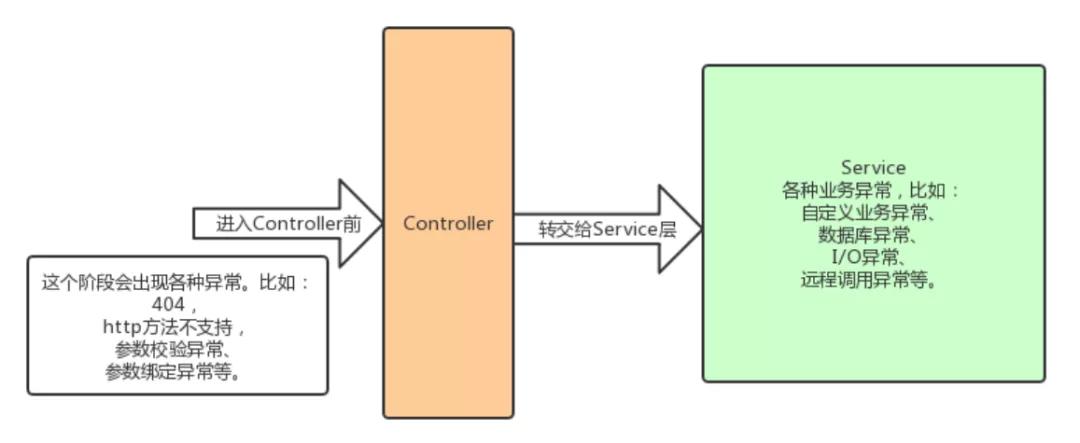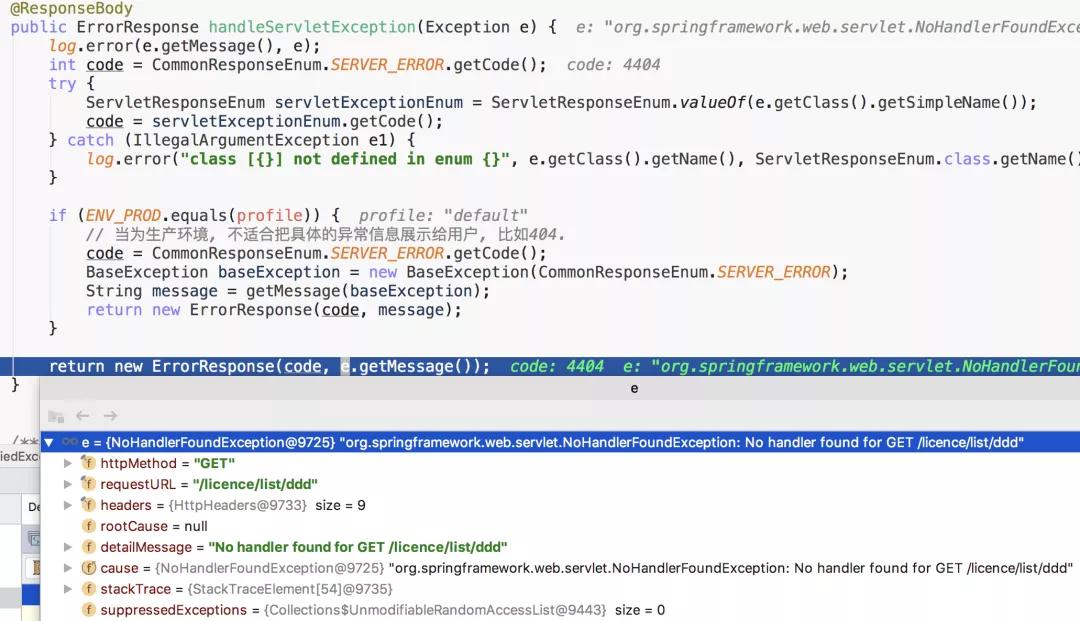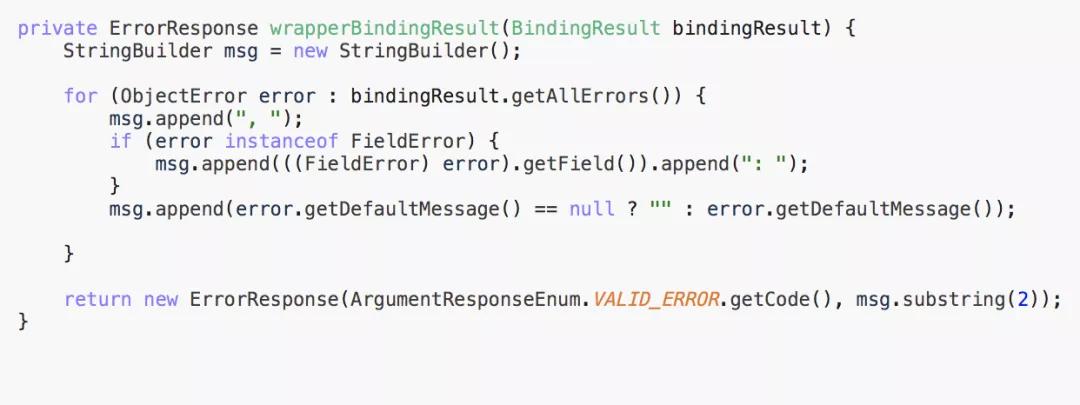软件开发过程中,不可避免的是需要处理各种异常,就我自己来说,至少有一半以上的时间都是在处理各种异常情况。
所以代码中就会出现大量的 try {...} catch {...} finally {...} 代码块,不仅有大量的冗余代码,而且还影响代码的可读性。
比较下面两张图,看看您现在编写的代码属于哪一种风格?然后哪种编码风格您更喜欢?
丑陋的 try catch 代码块,如下图:
优雅的 Controller,如下图:
上面的示例,还只是在 Controller 层,如果是在 Service 层,可能会有更多的 try catch 代码块。这将会严重影响代码的可读性、“美观性”。
所以如果是我的话,我肯定偏向于第二种,我可以把更多的精力放在业务代码的开发,同时代码也会变得更加简洁。
既然业务代码不显式地对异常进行捕获、处理,而异常肯定还是处理的,不然系统岂不是动不动就崩溃了,所以必须得有其他地方捕获并处理这些异常。
那么问题来了,如何优雅的处理各种异常?
什么是统一异常处理
Spring 在 3.2 版本增加了一个注解 @ControllerAdvice,可以与 @ExceptionHandler、@InitBinder、@ModelAttribute 等注解注解配套使用。
对于这几个注解的作用,这里不做过多赘述,若有不了解的,可以参考 Spring 3.2 新注解 @ControllerAdvice,先大概有个了解。
不过跟异常处理相关的只有注解 @ExceptionHandler,从字面上看,就是异常处理器的意思。
其实际作用是:若在某个 Controller 类定义一个异常处理方法,并在方法上添加该注解,那么当出现指定的异常时,会执行该处理异常的方法。
其可以使用 SpringMVC 提供的数据绑定,比如注入 HttpServletRequest 等,还可以接受一个当前抛出的 Throwable 对象。
但是,这样一来,就必须在每一个 Controller 类都定义一套这样的异常处理方法,因为异常可以是各种各样。
因此,就会造成大量的冗余代码,而且若需要新增一种异常的处理逻辑,就必须修改所有 Controller 类了,很不优雅。
当然你可能会说,那就定义个类似 BaseController 的基类,这样总行了吧。
这种做法虽然没错,但仍不尽善尽美,因为这样的代码有一定的侵入性和耦合性。
简简单单的 Controller,我为啥非得继承这样一个类呢,万一已经继承其他基类了呢。大家都知道 Java 只能继承一个类。
那有没有一种方案,既不需要跟 Controller 耦合,也可以将定义的异常处理器应用到所有控制器呢?
所以注解 @ControllerAdvice 出现了,简单的说,该注解可以把异常处理器应用到所有控制器,而不是单个控制器。
借助该注解,我们可以实现:在独立的某个地方,比如单独一个类,定义一套对各种异常的处理机制,然后在类的签名加上注解 @ControllerAdvice,统一对不同阶段的、不同异常进行处理。
这就是统一异常处理的原理。注意到上面对异常按阶段进行分类,大体可以分成:进入 Controller 前的异常和 Service 层异常。
具体可以参考下图:
不同阶段的异常
目标
消灭 95% 以上的 try catch 代码块,以优雅的 Assert(断言)方式来校验业务的异常情况,只关注业务逻辑,而不用花费大量精力写冗余的 try catch 代码块。
统一异常处理实战
在定义统一异常处理类之前,先来介绍一下如何优雅的判定异常情况并抛异常。
用 Assert(断言)替换 throw exception
想必 Assert(断言)大家都很熟悉,比如 Spring 家族的 org.springframework.util.Assert,在我们写测试用例的时候经常会用到,使用断言能让我们编码的时候有一种非一般丝滑的感觉。
比如:
@Test
public void test1() {
...
User user = userDao.selectById(userId);
Assert.notNull(user, "用户不存在.");
...
}
@Test
public void test2() {
// 另一种写法
User user = userDao.selectById(userId);
if (user == null) {
throw new IllegalArgumentException("用户不存在.");
}
}
- 1.
- 2.
- 3.
- 4.
- 5.
- 6.
- 7.
- 8.
- 9.
- 10.
- 11.
- 12.
- 13.
- 14.
- 15.
- 16.
有没有感觉第一种判定非空的写法很优雅,第二种写法则是相对丑陋的 if {...} 代码块。
那么神奇的 Assert.notNull() 背后到底做了什么呢?下面是 Assert 的部分源码:
public abstract class Assert {
public Assert() {
}
public static void notNull(@Nullable Object object, String message) {
if (object == null) {
throw new IllegalArgumentException(message);
}
}
}
- 1.
- 2.
- 3.
- 4.
- 5.
- 6.
- 7.
- 8.
- 9.
- 10.
可以看到,Assert 其实就是帮我们把 if {...} 封装了一下,是不是很神奇。虽然很简单,但不可否认的是编码体验至少提升了一个档次。
那么我们能不能模仿 org.springframework.util.Assert,也写一个断言类,不过断言失败后抛出的异常不是 IllegalArgumentException 这些内置异常,而是我们自己定义的异常。
①Assert
下面让我们来尝试一下:
public interface Assert {
/**
* 创建异常
* @param args
* @return
*/
BaseException newException(Object... args);
/**
* 创建异常
* @param t
* @param args
* @return
*/
BaseException newException(Throwable t, Object... args);
/**
* <p>断言对象<code>obj</code>非空。如果对象<code>obj</code>为空,则抛出异常
*
* @param obj 待判断对象
*/
default void assertNotNull(Object obj) {
if (obj == null) {
throw newException(obj);
}
}
/**
* <p>断言对象<code>obj</code>非空。如果对象<code>obj</code>为空,则抛出异常
* <p>异常信息<code>message</code>支持传递参数方式,避免在判断之前进行字符串拼接操作
*
* @param obj 待判断对象
* @param args message占位符对应的参数列表
*/
default void assertNotNull(Object obj, Object... args) {
if (obj == null) {
throw newException(args);
}
}
}
- 1.
- 2.
- 3.
- 4.
- 5.
- 6.
- 7.
- 8.
- 9.
- 10.
- 11.
- 12.
- 13.
- 14.
- 15.
- 16.
- 17.
- 18.
- 19.
- 20.
- 21.
- 22.
- 23.
- 24.
- 25.
- 26.
- 27.
- 28.
- 29.
- 30.
- 31.
- 32.
- 33.
- 34.
- 35.
- 36.
- 37.
- 38.
- 39.
- 40.
断言对象obj非空。如果对象obj为空,则抛出异常 * * @param obj 待判断对象 */ default void assertNotNull(Object obj) { if (obj == null) { throw newException(obj); } } /** *
断言对象obj非空。如果对象obj为空,则抛出异常 *
异常信息message支持传递参数方式,避免在判断之前进行字符串拼接操作 * * @param obj 待判断对象 * @param args message占位符对应的参数列表 */ default void assertNotNull(Object obj, Object... args) { if (obj == null) { throw newException(args); } }}
上面的 Assert 断言方法是使用接口的默认方法定义的,然后有没有发现当断言失败后,抛出的异常不是具体的某个异常,而是交由 2 个 newException 接口方法提供。
因为业务逻辑中出现的异常基本都是对应特定的场景,比如根据用户 id 获取用户信息,查询结果为 null,此时抛出的异常可能为 UserNotFoundException。
并且有特定的异常码(比如 7001)和异常信息“用户不存在”。所以具体抛出什么异常,有 Assert 的实现类决定。
看到这里,您可能会有这样的疑问,按照上面的说法,那岂不是有多少异常情况,就得有定义等量的断言类和异常类,这显然是反人类的,这也没想象中高明嘛。别急,且听我细细道来。
②善解人意的 Enum
自定义异常 BaseException 有 2 个属性,即 code、message,这样一对属性,有没有想到什么类一般也会定义这 2 个属性?
没错,就是枚举类。且看我如何将 Enum 和 Assert 结合起来,相信我一定会让你眼前一亮。
如下:
public interface IResponseEnum {
int getCode();
String getMessage();
}
/**
* <p>业务异常</p>
* <p>业务处理时,出现异常,可以抛出该异常</p>
*/
public class BusinessException extends BaseException {
private static final long serialVersionUID = 1L;
public BusinessException(IResponseEnum responseEnum, Object[] args, String message) {
super(responseEnum, args, message);
}
public BusinessException(IResponseEnum responseEnum, Object[] args, String message, Throwable cause) {
super(responseEnum, args, message, cause);
}
}
public interface BusinessExceptionAssert extends IResponseEnum, Assert {
@Override
default BaseException newException(Object... args) {
String msg = MessageFormat.format(this.getMessage(), args);
return new BusinessException(this, args, msg);
}
@Override
default BaseException newException(Throwable t, Object... args) {
String msg = MessageFormat.format(this.getMessage(), args);
return new BusinessException(this, args, msg, t);
}
}
@Getter
@AllArgsConstructor
public enum ResponseEnum implements BusinessExceptionAssert {
/**
* Bad licence type
*/
BAD_LICENCE_TYPE(7001, "Bad licence type."),
/**
* Licence not found
*/
LICENCE_NOT_FOUND(7002, "Licence not found.")
;
/**
* 返回码
*/
private int code;
/**
* 返回消息
*/
private String message;
}
- 1.
- 2.
- 3.
- 4.
- 5.
- 6.
- 7.
- 8.
- 9.
- 10.
- 11.
- 12.
- 13.
- 14.
- 15.
- 16.
- 17.
- 18.
- 19.
- 20.
- 21.
- 22.
- 23.
- 24.
- 25.
- 26.
- 27.
- 28.
- 29.
- 30.
- 31.
- 32.
- 33.
- 34.
- 35.
- 36.
- 37.
- 38.
- 39.
- 40.
- 41.
- 42.
- 43.
- 44.
- 45.
- 46.
- 47.
- 48.
- 49.
- 50.
- 51.
- 52.
- 53.
- 54.
- 55.
- 56.
- 57.
- 58.
- 59.
- 60.
看到这里,有没有眼前一亮的感觉,代码示例中定义了两个枚举实例:
- BAD_LICENCE_TYPE
- LICENCE_NOT_FOUND
分别对应了 BadLicenceTypeException、LicenceNotFoundException 两种异常。
以后每增加一种异常情况,只需增加一个枚举实例即可,再也不用每一种异常都定义一个异常类了。
然后再来看下如何使用,假设 LicenceService 有校验 Licence 是否存在的方法,如下:
/**
* 校验{@link Licence}存在
* @param licence
*/
private void checkNotNull(Licence licence) {
ResponseEnum.LICENCE_NOT_FOUND.assertNotNull(licence);
}
- 1.
- 2.
- 3.
- 4.
- 5.
- 6.
- 7.
若不使用断言,代码可能如下:
private void checkNotNull(Licence licence) {
if (licence == null) {
throw new LicenceNotFoundException();
// 或者这样
throw new BusinessException(7001, "Bad licence type.");
}
}
- 1.
- 2.
- 3.
- 4.
- 5.
- 6.
- 7.
使用枚举类结合(继承)Assert,只需根据特定的异常情况定义不同的枚举实例,如上面的 BAD_LICENCE_TYPE、LICENCE_NOT_FOUND,就能够针对不同情况抛出特定的异常(这里指携带特定的异常码和异常消息)。
这样既不用定义大量的异常类,同时还具备了断言的良好可读性,当然这种方案的好处远不止这些,请继续阅读后文,慢慢体会。
注:上面举的例子是针对特定的业务,而有部分异常情况是通用的,比如:服务器繁忙、网络异常、服务器异常、参数校验异常、404 等。
所以有 CommonResponseEnum、ArgumentResponseEnum、ServletResponseEnum,其中 ServletResponseEnum 会在后文详细说明。
定义统一异常处理器类
@Slf4j
@Component
@ControllerAdvice
@ConditionalOnWebApplication
@ConditionalOnMissingBean(UnifiedExceptionHandler.class)
public class UnifiedExceptionHandler {
/**
* 生产环境
*/
private final static String ENV_PROD = "prod";
@Autowired
private UnifiedMessageSource unifiedMessageSource;
/**
* 当前环境
*/
@Value("${spring.profiles.active}")
private String profile;
/**
* 获取国际化消息
*
* @param e 异常
* @return
*/
public String getMessage(BaseException e) {
String code = "response." + e.getResponseEnum().toString();
String message = unifiedMessageSource.getMessage(code, e.getArgs());
if (message == null || message.isEmpty()) {
return e.getMessage();
}
return message;
}
/**
* 业务异常
*
* @param e 异常
* @return 异常结果
*/
@ExceptionHandler(value = BusinessException.class)
@ResponseBody
public ErrorResponse handleBusinessException(BaseException e) {
log.error(e.getMessage(), e);
return new ErrorResponse(e.getResponseEnum().getCode(), getMessage(e));
}
/**
* 自定义异常
*
* @param e 异常
* @return 异常结果
*/
@ExceptionHandler(value = BaseException.class)
@ResponseBody
public ErrorResponse handleBaseException(BaseException e) {
log.error(e.getMessage(), e);
return new ErrorResponse(e.getResponseEnum().getCode(), getMessage(e));
}
/**
* Controller上一层相关异常
*
* @param e 异常
* @return 异常结果
*/
@ExceptionHandler({
NoHandlerFoundException.class,
HttpRequestMethodNotSupportedException.class,
HttpMediaTypeNotSupportedException.class,
MissingPathVariableException.class,
MissingServletRequestParameterException.class,
TypeMismatchException.class,
HttpMessageNotReadableException.class,
HttpMessageNotWritableException.class,
// BindException.class,
// MethodArgumentNotValidException.class
HttpMediaTypeNotAcceptableException.class,
ServletRequestBindingException.class,
ConversionNotSupportedException.class,
MissingServletRequestPartException.class,
AsyncRequestTimeoutException.class
})
@ResponseBody
public ErrorResponse handleServletException(Exception e) {
log.error(e.getMessage(), e);
int code = CommonResponseEnum.SERVER_ERROR.getCode();
try {
ServletResponseEnum servletExceptionEnum = ServletResponseEnum.valueOf(e.getClass().getSimpleName());
code = servletExceptionEnum.getCode();
} catch (IllegalArgumentException e1) {
log.error("class [{}] not defined in enum {}", e.getClass().getName(), ServletResponseEnum.class.getName());
}
if (ENV_PROD.equals(profile)) {
// 当为生产环境, 不适合把具体的异常信息展示给用户, 比如404.
code = CommonResponseEnum.SERVER_ERROR.getCode();
BaseException baseException = new BaseException(CommonResponseEnum.SERVER_ERROR);
String message = getMessage(baseException);
return new ErrorResponse(code, message);
}
return new ErrorResponse(code, e.getMessage());
}
/**
* 参数绑定异常
*
* @param e 异常
* @return 异常结果
*/
@ExceptionHandler(value = BindException.class)
@ResponseBody
public ErrorResponse handleBindException(BindException e) {
log.error("参数绑定校验异常", e);
return wrapperBindingResult(e.getBindingResult());
}
/**
* 参数校验异常,将校验失败的所有异常组合成一条错误信息
*
* @param e 异常
* @return 异常结果
*/
@ExceptionHandler(value = MethodArgumentNotValidException.class)
@ResponseBody
public ErrorResponse handleValidException(MethodArgumentNotValidException e) {
log.error("参数绑定校验异常", e);
return wrapperBindingResult(e.getBindingResult());
}
/**
* 包装绑定异常结果
*
* @param bindingResult 绑定结果
* @return 异常结果
*/
private ErrorResponse wrapperBindingResult(BindingResult bindingResult) {
StringBuilder msg = new StringBuilder();
for (ObjectError error : bindingResult.getAllErrors()) {
msg.append(", ");
if (error instanceof FieldError) {
msg.append(((FieldError) error).getField()).append(": ");
}
msg.append(error.getDefaultMessage() == null ? "" : error.getDefaultMessage());
}
return new ErrorResponse(ArgumentResponseEnum.VALID_ERROR.getCode(), msg.substring(2));
}
/**
* 未定义异常
*
* @param e 异常
* @return 异常结果
*/
@ExceptionHandler(value = Exception.class)
@ResponseBody
public ErrorResponse handleException(Exception e) {
log.error(e.getMessage(), e);
if (ENV_PROD.equals(profile)) {
// 当为生产环境, 不适合把具体的异常信息展示给用户, 比如数据库异常信息.
int code = CommonResponseEnum.SERVER_ERROR.getCode();
BaseException baseException = new BaseException(CommonResponseEnum.SERVER_ERROR);
String message = getMessage(baseException);
return new ErrorResponse(code, message);
}
return new ErrorResponse(CommonResponseEnum.SERVER_ERROR.getCode(), e.getMessage());
}
}
- 1.
- 2.
- 3.
- 4.
- 5.
- 6.
- 7.
- 8.
- 9.
- 10.
- 11.
- 12.
- 13.
- 14.
- 15.
- 16.
- 17.
- 18.
- 19.
- 20.
- 21.
- 22.
- 23.
- 24.
- 25.
- 26.
- 27.
- 28.
- 29.
- 30.
- 31.
- 32.
- 33.
- 34.
- 35.
- 36.
- 37.
- 38.
- 39.
- 40.
- 41.
- 42.
- 43.
- 44.
- 45.
- 46.
- 47.
- 48.
- 49.
- 50.
- 51.
- 52.
- 53.
- 54.
- 55.
- 56.
- 57.
- 58.
- 59.
- 60.
- 61.
- 62.
- 63.
- 64.
- 65.
- 66.
- 67.
- 68.
- 69.
- 70.
- 71.
- 72.
- 73.
- 74.
- 75.
- 76.
- 77.
- 78.
- 79.
- 80.
- 81.
- 82.
- 83.
- 84.
- 85.
- 86.
- 87.
- 88.
- 89.
- 90.
- 91.
- 92.
- 93.
- 94.
- 95.
- 96.
- 97.
- 98.
- 99.
- 100.
- 101.
- 102.
- 103.
- 104.
- 105.
- 106.
- 107.
- 108.
- 109.
- 110.
- 111.
- 112.
- 113.
- 114.
- 115.
- 116.
- 117.
- 118.
- 119.
- 120.
- 121.
- 122.
- 123.
- 124.
- 125.
- 126.
- 127.
- 128.
- 129.
- 130.
- 131.
- 132.
- 133.
- 134.
- 135.
- 136.
- 137.
- 138.
- 139.
- 140.
- 141.
- 142.
- 143.
- 144.
- 145.
- 146.
- 147.
- 148.
- 149.
- 150.
- 151.
- 152.
- 153.
- 154.
- 155.
- 156.
- 157.
- 158.
- 159.
- 160.
- 161.
- 162.
- 163.
- 164.
- 165.
- 166.
- 167.
- 168.
- 169.
- 170.
- 171.
- 172.
- 173.
- 174.
- 175.
- 176.
- 177.
- 178.
- 179.
- 180.
- 181.
- 182.
- 183.
可以看到,上面将异常分成几类,实际上只有两大类,一类是 ServletException、ServiceException,还记得上文提到的按阶段分类吗?
即对应进入 Controller 前的异常和 Service 层异常;然后 ServiceException 再分成自定义异常、未知异常。
对应关系如下:
- 进入 Controller 前的异常:handleServletException、handleBindException、handleValidException。
- 自定义异常:handleBusinessException、handleBaseException。
- 未知异常:handleException。
接下来分别对这几种异常处理器做详细说明。
①异常处理器说明
handleServletException:一个 HTTP 请求,在到达 Controller 前,会对该请求的请求信息与目标控制器信息做一系列校验。
这里简单说一下:
1.NoHandlerFoundException:首先根据请求 URL 查找有没有对应的控制器,若没有则会抛该异常,也就是大家非常熟悉的 404 异常。
2.HttpRequestMethodNotSupportedException:若匹配到了(匹配结果是一个列表,不同的是 HTTP 方法不同,如:Get、Post 等),则尝试将请求的 HTTP 方法与列表的控制器做匹配,若没有对应 HTTP 方法的控制器,则抛该异常。
3.HttpMediaTypeNotSupportedException:然后再对请求头与控制器支持的做比较。
比如 content-type 请求头,若控制器的参数签名包含注解 @RequestBody,但是请求的 content-type 请求头的值没有包含 application/json,那么会抛该异常(当然,不止这种情况会抛这个异常)。
4.MissingPathVariableException:未检测到路径参数。比如 URL 为:/licence/{licenceId},参数签名包含 @PathVariable("licenceId")。
当请求的 URL 为 /licence,在没有明确定义 URL 为 /licence 的情况下,会被判定为:缺少路径参数。
5.MissingServletRequestParameterException:缺少请求参数。比如定义了参数 @RequestParam("licenceId") String licenceId,但发起请求时,未携带该参数,则会抛该异常。
6.TypeMismatchException:参数类型匹配失败。比如:接收参数为 Long 型,但传入的值确是一个字符串,那么将会出现类型转换失败的情况,这时会抛该异常。
7.HttpMessageNotReadableException:与上面的 HttpMediaTypeNotSupportedException 举的例子完全相反。
即请求头携带了"content-type: application/json;charset=UTF-8",但接收参数却没有添加注解 @RequestBody,或者请求体携带的 json 串反序列化成 pojo 的过程中失败了,也会抛该异常。
8.HttpMessageNotWritableException:返回的 pojo 在序列化成 json 过程失败了,那么抛该异常。
9.HttpMediaTypeNotAcceptableException:未知。
10.ServletRequestBindingException:未知。
11.ConversionNotSupportedException:未知。
12.MissingServletRequestPartException:未知。
13.AsyncRequestTimeoutException:未知。
handleBindException:参数校验异常,后文详细说明。
handleValidException:参数校验异常,后文详细说明。
handleBusinessException、handleBaseException:处理自定义的业务异常,只是 handleBaseException 处理的是除了 BusinessException 意外的所有业务异常。就目前来看,这 2 个是可以合并成一个的。
handleException:处理所有未知的异常,比如操作数据库失败的异常。
注:上面的 handleServletException、handleException 这两个处理器,返回的异常信息,不同环境返回的可能不一样,以为这些异常信息都是框架自带的异常信息,一般都是英文的,不太好直接展示给用户看,所以统一返回 SERVER_ERROR 代表的异常信息。
②异于常人的 404
上文提到,当请求没有匹配到控制器的情况下,会抛出 NoHandlerFoundException 异常。
但其实默认情况下不是这样,默认情况下会出现类似如下页面:
Whitelabel Error Page
这个页面是如何出现的呢?实际上,当出现 404 的时候,默认是不抛异常的,而是 forward 跳转到 /error 控制器,Spring 也提供了默认的 error 控制器。
如下:
BasicErrorController
那么,如何让 404 也抛出异常呢,只需在 properties 文件中加入如下配置即可:
spring.mvc.throw-exception-if-no-handler-found=true
spring.resources.add-mappings=false
- 1.
- 2.
如此,就可以异常处理器中捕获它了,然后前端只要捕获到特定的状态码,立即跳转到 404 页面即可。
③捕获 404 对应的异常
统一返回结果
在验证统一异常处理器之前,顺便说一下统一返回结果。说白了,其实是统一一下返回结果的数据结构。
code、message 是所有返回结果中必有的字段,而当需要返回数据时,则需要另一个字段 data 来表示。
所以首先定义一个 BaseResponse 来作为所有返回结果的基类;然后定义一个通用返回结果类 CommonResponse,继承 BaseResponse,而且多了字段data。
为了区分成功和失败返回结果,于是再定义一个 ErrorResponse。
最后还有一种常见的返回结果,即返回的数据带有分页信息,因为这种接口比较常见,所以有必要单独定义一个返回结果类 QueryDataResponse。
该类继承自 CommonResponse,只是把 data 字段的类型限制为 QueryDdata,QueryDdata 中定义了分页信息相应的字段,即 totalCount、pageNo、 pageSize、records。
其中比较常用的只有 CommonResponse 和 QueryDataResponse,但是名字又贼鬼死长,何不定义 2 个名字超简单的类来替代呢?
于是 R 和 QR 诞生了,以后返回结果的时候只需这样写:new R<>(data)、new QR<>(queryData)。
所有的返回结果类的定义这里就不贴出来了。
验证统一异常处理
因为这一套统一异常处理可以说是通用的,所有可以设计成一个 common 包,以后每一个新项目/模块只需引入该包即可。所以为了验证,需要新建一个项目,并引入该 common 包。
主要代码
下面是用于验证的主要源码:
@Service
public class LicenceService extends ServiceImpl<LicenceMapper, Licence> {
@Autowired
private OrganizationClient organizationClient;
/**
* 查询{@link Licence} 详情
* @param licenceId
* @return
*/
public LicenceDTO queryDetail(Long licenceId) {
Licence licence = this.getById(licenceId);
checkNotNull(licence);
OrganizationDTO org = ClientUtil.execute(() -> organizationClient.getOrganization(licence.getOrganizationId()));
return toLicenceDTO(licence, org);
}
/**
* 分页获取
* @param licenceParam 分页查询参数
* @return
*/
public QueryData<SimpleLicenceDTO> getLicences(LicenceParam licenceParam) {
String licenceType = licenceParam.getLicenceType();
LicenceTypeEnum licenceTypeEnum = LicenceTypeEnum.parseOfNullable(licenceType);
// 断言, 非空
ResponseEnum.BAD_LICENCE_TYPE.assertNotNull(licenceTypeEnum);
LambdaQueryWrapper<Licence> wrapper = new LambdaQueryWrapper<>();
wrapper.eq(Licence::getLicenceType, licenceType);
IPage<Licence> page = this.page(new QueryPage<>(licenceParam), wrapper);
return new QueryData<>(page, this::toSimpleLicenceDTO);
}
/**
* 新增{@link Licence}
* @param request 请求体
* @return
*/
@Transactional(rollbackFor = Throwable.class)
public LicenceAddRespData addLicence(LicenceAddRequest request) {
Licence licence = new Licence();
licence.setOrganizationId(request.getOrganizationId());
licence.setLicenceType(request.getLicenceType());
licence.setProductName(request.getProductName());
licence.setLicenceMax(request.getLicenceMax());
licence.setLicenceAllocated(request.getLicenceAllocated());
licence.setComment(request.getComment());
this.save(licence);
return new LicenceAddRespData(licence.getLicenceId());
}
/**
* entity -> simple dto
* @param licence {@link Licence} entity
* @return {@link SimpleLicenceDTO}
*/
private SimpleLicenceDTO toSimpleLicenceDTO(Licence licence) {
// 省略
}
/**
* entity -> dto
* @param licence {@link Licence} entity
* @param org {@link OrganizationDTO}
* @return {@link LicenceDTO}
*/
private LicenceDTO toLicenceDTO(Licence licence, OrganizationDTO org) {
// 省略
}
/**
* 校验{@link Licence}存在
* @param licence
*/
private void checkNotNull(Licence licence) {
ResponseEnum.LICENCE_NOT_FOUND.assertNotNull(licence);
}
}
- 1.
- 2.
- 3.
- 4.
- 5.
- 6.
- 7.
- 8.
- 9.
- 10.
- 11.
- 12.
- 13.
- 14.
- 15.
- 16.
- 17.
- 18.
- 19.
- 20.
- 21.
- 22.
- 23.
- 24.
- 25.
- 26.
- 27.
- 28.
- 29.
- 30.
- 31.
- 32.
- 33.
- 34.
- 35.
- 36.
- 37.
- 38.
- 39.
- 40.
- 41.
- 42.
- 43.
- 44.
- 45.
- 46.
- 47.
- 48.
- 49.
- 50.
- 51.
- 52.
- 53.
- 54.
- 55.
- 56.
- 57.
- 58.
- 59.
- 60.
- 61.
- 62.
- 63.
- 64.
- 65.
- 66.
- 67.
- 68.
- 69.
- 70.
- 71.
- 72.
- 73.
- 74.
- 75.
- 76.
- 77.
- 78.
- 79.
- 80.
- 81.
- 82.
- 83.
PS:这里使用的 DAO 框架是 mybatis-plus。启动时,自动插入的数据为:
-- licence
INSERT INTO licence (licence_id, organization_id, licence_type, product_name, licence_max, licence_allocated)
VALUES (1, 1, 'user','CustomerPro', 100,5);
INSERT INTO licence (licence_id, organization_id, licence_type, product_name, licence_max, licence_allocated)
VALUES (2, 1, 'user','suitability-plus', 200,189);
INSERT INTO licence (licence_id, organization_id, licence_type, product_name, licence_max, licence_allocated)
VALUES (3, 2, 'user','HR-PowerSuite', 100,4);
INSERT INTO licence (licence_id, organization_id, licence_type, product_name, licence_max, licence_allocated)
VALUES (4, 2, 'core-prod','WildCat Application Gateway', 16,16);
-- organizations
INSERT INTO organization (id, name, contact_name, contact_email, contact_phone)
VALUES (1, 'customer-crm-co', 'Mark Balster', 'mark.balster@custcrmco.com', '823-555-1212');
INSERT INTO organization (id, name, contact_name, contact_email, contact_phone)
VALUES (2, 'HR-PowerSuite', 'Doug Drewry','doug.drewry@hr.com', '920-555-1212');
- 1.
- 2.
- 3.
- 4.
- 5.
- 6.
- 7.
- 8.
- 9.
- 10.
- 11.
- 12.
- 13.
- 14.
- 15.
开始验证
捕获自定义异常
①获取不存在的 licence 详情:http://localhost:10000/licence/5。成功响应的请求:licenceId=1。
检验非空
捕获 Licence not found 异常
Licence not found
②根据不存在的 licence type 获取 licence 列表:http://localhost:10000/licence/list?licenceType=ddd。可选的 licence type 为:user、core-prod 。
校验非空
捕获 Bad licence type 异常
Bad licence type
捕获进入 Controller 前的异常
①访问不存在的接口:http://localhost:10000/licence/list/ddd
捕获 404 异常
②HTTP 方法不支持:http://localhost:10000/licence。
PostMapping
捕获 Request method not supported 异常
Request method not supported
③校验异常 1:http://localhost:10000/licence/list?licenceType=
getLicences
LicenceParam
捕获参数绑定校验异常
licence type cannot be empty
④校验异常 2:post 请求,这里使用 postman 模拟。
addLicence
LicenceAddRequest
请求 url 即结果
捕获参数绑定校验异常
注:因为参数绑定校验异常的异常信息的获取方式与其它异常不一样,所以才把这 2 种情况的异常从进入 Controller 前的异常单独拆出来。
下面是异常信息的收集逻辑:
异常信息的收集
捕获未知异常
假设我们现在随便对 Licence 新增一个字段 test,但不修改数据库表结构,然后访问:http://localhost:10000/licence/1。
增加 test 字段
捕获数据库异常
Error querying database
小结:可以看到,测试的异常都能够被捕获,然后以 code、message 的形式返回。
每一个项目/模块,在定义业务异常的时候,只需定义一个枚举类,然后实现接口 BusinessExceptionAssert,最后为每一种业务异常定义对应的枚举实例即可,而不用定义许多异常类。使用的时候也很方便,用法类似断言。
扩展:在生产环境,若捕获到未知异常或者 ServletException,因为都是一长串的异常信息,若直接展示给用户看,显得不够专业,于是,我们可以这样做:当检测到当前环境是生产环境,那么直接返回 "网络异常"。
生产环境返回“网络异常”
可以通过以下方式修改当前环境:
修改当前环境为生产环境
总结
使用断言和枚举类相结合的方式,再配合统一异常处理,基本大部分的异常都能够被捕获。
为什么说大部分异常,因为当引入 Spring Cloud Security 后,还会有认证/授权异常,网关的服务降级异常、跨模块调用异常、远程调用第三方服务异常等。
这些异常的捕获方式与本文介绍的不太一样,不过限于篇幅,这里不做详细说明,以后会有单独的文章介绍。
另外,当需要考虑国际化的时候,捕获异常后的异常信息一般不能直接返回,需要转换成对应的语言,不过本文已考虑到了这个,获取消息的时候已经做了国际化映射,逻辑如下:
获取国际化消息
最后总结,全局异常属于老生长谈的话题,希望这次通过手机的项目对大家有点指导性的学习。大家根据实际情况自行修改。
也可以采用以下的 jsonResult 对象的方式进行处理,也贴出来代码:
@Slf4j
@RestControllerAdvice
public class GlobalExceptionHandler {
/**
* 没有登录
* @param request
* @param response
* @param e
* @return
*/
@ExceptionHandler(NoLoginException.class)
public Object noLoginExceptionHandler(HttpServletRequest request,HttpServletResponse response,Exception e)
{
log.error("[GlobalExceptionHandler][noLoginExceptionHandler] exception",e);
JsonResult jsonResult = new JsonResult();
jsonResult.setCode(JsonResultCode.NO_LOGIN);
jsonResult.setMessage("用户登录失效或者登录超时,请先登录");
return jsonResult;
}
/**
* 业务异常
* @param request
* @param response
* @param e
* @return
*/
@ExceptionHandler(ServiceException.class)
public Object businessExceptionHandler(HttpServletRequest request,HttpServletResponse response,Exception e)
{
log.error("[GlobalExceptionHandler][businessExceptionHandler] exception",e);
JsonResult jsonResult = new JsonResult();
jsonResult.setCode(JsonResultCode.FAILURE);
jsonResult.setMessage("业务异常,请联系管理员");
return jsonResult;
}
/**
* 全局异常处理
* @param request
* @param response
* @param e
* @return
*/
@ExceptionHandler(Exception.class)
public Object exceptionHandler(HttpServletRequest request,HttpServletResponse response,Exception e)
{
log.error("[GlobalExceptionHandler][exceptionHandler] exception",e);
JsonResult jsonResult = new JsonResult();
jsonResult.setCode(JsonResultCode.FAILURE);
jsonResult.setMessage("系统错误,请联系管理员");
return jsonResult;
}
}
- 1.
- 2.
- 3.
- 4.
- 5.
- 6.
- 7.
- 8.
- 9.
- 10.
- 11.
- 12.
- 13.
- 14.
- 15.
- 16.
- 17.
- 18.
- 19.
- 20.
- 21.
- 22.
- 23.
- 24.
- 25.
- 26.
- 27.
- 28.
- 29.
- 30.
- 31.
- 32.
- 33.
- 34.
- 35.
- 36.
- 37.
- 38.
- 39.
- 40.
- 41.
- 42.
- 43.
- 44.
- 45.
- 46.
- 47.
- 48.
- 49.
- 50.
- 51.
- 52.
- 53.
- 54.
- 55.
作者:巨人大哥
编辑:陶家龙
出处:cnblogs.com/jurendage/p/11255197.html































































